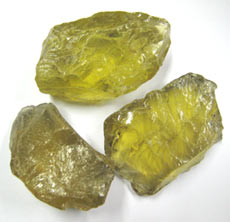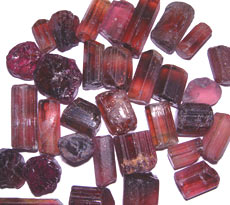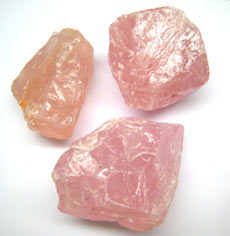|
|
Your Details
|
|
Your Details
|
Reviewed By Andreas Zabczyk
Loose Gemstones - From the Mine to the MarketHow do loose gemstones get from the mine to the international gems and Jewelry market? Are there a few big buyers who get first choice of the best stones, leaving the second rate stuff for the rest of us? If you went directly to the mine could you get the best deal on loose rubies or loose sapphires?  Lemon Quartz from an African Gem Mine
We are asked these sorts of questions on a regular basis. The supply chain for loose colored gemstones is a mystery to many, including many gem dealers who don't buy or sell rough gemstones. By the time colored gems arrive in America or Europe they may have passed through dozens of hands since being mined, and each pair of hands that touches the gems adds another 20-50% to the final selling price. The prices would be absolutely amazing, if only the middlemen could be cut out. This would mean no more rip-off prices when shopping for loose gemstones! Gemstone Supply ChainOne reason why the supply chain for colored gems is a bit of a mystery is that colored stones, unlike diamonds, are mostly mined by independent, small-scale miners, working in remote locations in far away places such as Sri Lanka, Madagascar, Tanzania, Kenya, Pakistan, Burma, Afghanistan, Columbia and Bolivia. Mining is usually carried out with picks and shovels, and only rarely with heavy equipment. In Sri Lanka, for example, there are more than 5,000 registered colored gemstone mining locations on the island. The majority of these pits measure no more than three by three meters, with a maximum depth of 25 meters. Colored gemstone mining is so labor-intensive that over 500,000 people in Madagascar are estimated to be involved in the gemstone sector, despite the fact that Madagascar only became an important gemstone source in the 1990s.  Pink Tourmaline Crystals
Independent miners typically want to turn their hard work into cash as soon as possible. Usually this means taking the rough stone to a local market in the nearest town or selling the rough to someone who has transportation to the local market. Miners very rarely sell to foreign buyers at the mine. For one thing, foreign buyers must find the mine, which is often a difficult and dangerous task. Additionally, the miner is not really interested in disclosing his mining location! The Local Gemstone MarketThe local market may or may not be open to foreign buyers. Local businessmen see an opportunity to act as middleman who go between the miner and the foreign buyers, and there may be several levels of middlemen, who each take a share. These middlemen know the price that the rough stone will fetch in the international market and if the prices for gemstones are are too low in the local market they will arrange to take the goods abroad to maximize their profits. So the idea that you can take a trip to the mining source and buy loose gemstones at a tremendous bargain is really a myth. The middlemen in the local market are not the only route to the international gems market. Many miners realize that selling to local businessman is not a good economic strategy. Why let the middleman take most of the profit when the miner has done all the hard work? Thus many miners develop business relationships with relatives or trusted friends who will take the rough stone to the foreign market and obtain a much better price.  Rough Pink Rose Quartz Crystals
Gemstone Trading in Chanthaburi, ThailandMany of the African gem traders we see here in Chanthaburi, Thailand, have direct relationships with miners in their home country. These traders come to Chanthaburi because there are a large number of gem dealers here who know how to process the rough stone and will pay a fair market price for it. Most importantly, there is a constant demand here so that traders are assured of being able to move their goods quickly. A gem processing center like Chanthaburi plays an important role in the international supply chain. Since gem cutting is still largely a cottage industry here, traders can sell small lots that wouldn't be of interest to a huge factory. Chanthaburi dealers reach the market for their finished loose gemstones via Bangkok or, in the case of GemSelect, through the Internet. A loose sapphire from the GemSelect website may actually have passed through only a few hands since being mined. This sort of efficiency in the supply chain can lead to huge disparities in price. Check the price per carat of loose sapphire, tourmaline and spinel in your local jewelry store and you'll get a clear sense of what happens when there are dozens of steps in the supply chain. |
